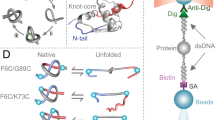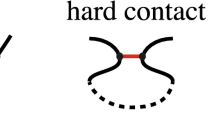Abstract
Many experiments have been done to determine the relative strengths of different knots, and these show that the break in a knotted rope almost invariably occurs at the point just outside the ‘entrance’ to the knot1. The influence of knots on the properties of polymers has become of great interest, in part because of their effect on mechanical properties2. Knot theory3,4 applied to the topology of macromolecules5,6,7,8 indicates that the simple trefoil or ‘overhand’ knot is likely to be present in any long polymer strand9,10,11,12. Fragments of DNA have been observed to contain such knots in experiments13,14 and computer simulations15. Here we use ab initio computational methods16 to investigate the effect of a trefoil knot on the breaking strength of a polymer strand. We find that the knot weakens the strand significantly, and that, like a knotted rope, it breaks under tension at the entrance to the knot.
This is a preview of subscription content, access via your institution
Access options
Subscribe to this journal
Receive 51 print issues and online access
$199.00 per year
only $3.90 per issue
Buy this article
- Purchase on Springer Link
- Instant access to full article PDF
Prices may be subject to local taxes which are calculated during checkout




Similar content being viewed by others
References
Ashley, C. W. The Ashley Book of Knots(Doubleday, New York, (1993).
Bayer, R. K. Structure transfer from a polymeric melt to the solid state. Part III: Influence of knots on structure and mechanical properties of semicrystalline polymers. Colloid Polym. Sci. 272, 910–932 (1994).
Atiyha, M. F. The Geometry and Physics of Knots(Cambridge Univ. Press, (1990).
Katritch, V. et al . Geometry and physics of knots. Nature 383, 142–145 (1996); Properties of ideal composite knots. Nature 388, 148–151 (1997).
Frisch, H. L. & Wasserman, E. Chemical topology, J. Am. Chem. Soc. 83, 3789–3795 (1961).
Mislow, K. Introduction to Stereochemistry(Benjamin, New York, (1965).
Schill, G. Catenanes, Rotaxanes, and Knots(Academic, New York, (1971).
Walba, D. M. Topological stereochemistry. Tetrahedron 41, 3161–3212 (1985).
Frank-Kamenetskii, M. D., Lukashin, A. V. & Vologodskii, A. V. Statistical mechanics and topology of polymer chains. Nature 258, 398–402 (1975).
Frisch, H. L. Macromolecular topology—Metastable isomers from pseudo interpenetrating polymer networks. New J. Chem. 17, 697–701 (1993).
Mansfield, M. L. Knots in hamiltonian cycles. Macromolecules 27, 5924–5926 (1994).
van Rensburg, E. J., Sumners, D. A. W., Wasserman, E. & Whittington, S. G. Entanglement complexity of self-avoiding walks. J. Phys. A 25, 6557–6566 (1992).
Wasserman, S. A. & Cozzarelli, N. R. Biochemical topology: applications to DNA recombination and replication. Science 232, 951–960 (1986).
Shaw, S. Y. & Wang, J. C. Knotting of a DNA chain during ring closure. Science 260, 533–536 (1993).
Schlick, T. & Olson, W. K. Trefoil knotting revealed by molecular dynamics simulations of supercoiled DNA. Science 257, 1110–1115 (1992).
Car, R. & Parrinello, M. Unified approach for molecular dynamics and density-functional theory. Phys. Rev. Lett. 55, 2471–2474 (1985).
de Gennes, P.-G. Tight knots. Macromolecules 17, 703–704 (1984).
Siepmann, J. I., Karaborni, S. & Smit, B. Simulating the critical-behaviour of complex fluids. Nature 365, 330–332 (1993).
Mundy, C. J., Balasubramanian, S., Bagchi, K., Siepmann, J. I. & Klein, M. L. Equilibrium and non-equilibrium simulation studies of fluid alkanes in bulk and at interfaces. Faraday Discuss. 104, 17–36 (1996).
Karasawa, N., Dasgupta, S. & Goddard, W. A. Mechanical properties and force-field parameters for polyethylene crystal. J. Phys. Chem. US 95, 2260–2272 (1991).
Ancilotto, F., Chiarotti, G. L., Scandolo, S. & Tosatti, E. Dissociation of methane into hydrocarbons at extreme (planetary) pressure and temperature. Science 275, 1288–1290 (1997).
Montanari, B. & Jones, R. O. Density functional study of crystalline polyethylene. Chem. Phys. Lett. 272, 347–352 (1997).
Martyna, G. J. et al . PINY Code. Comp. Phys. Comm.(in the press).
Becke, A. D. Density-functional exchange-energy approximation with correct asymptotic behavior. Phys. Rev. A 38, 3098–3100 (1988).
Lee, C., Chang, W. & Parr, R. G. Development of the Colle-Salvetti correlation-energy formula into a functional of the electron density. Phys. Rev. B 37, 785–789 (1988).
Arai, Y. et al . Tying a molecular knot with optical tweezers. Nature(in the press).
Acknowledgements
This work was supported in part by the National Science Foundation.
Author information
Authors and Affiliations
Corresponding author
Rights and permissions
About this article
Cite this article
Saitta, A., Soper, P., Wasserman, E. et al. Influence of a knot on the strength of a polymer strand. Nature 399, 46–48 (1999). https://doi.org/10.1038/19935
Received:
Accepted:
Issue Date:
DOI: https://doi.org/10.1038/19935
This article is cited by
-
Mechanical scission of a knotted polymer
Nature Chemistry (2024)
-
Molecular weaving
Nature Materials (2022)
-
A molecular endless (74) knot
Nature Chemistry (2021)
-
Hydrodynamic inflation of ring polymers under shear
Communications Materials (2020)
-
Knotting a molecular strand can invert macroscopic effects of chirality
Nature Chemistry (2020)
Comments
By submitting a comment you agree to abide by our Terms and Community Guidelines. If you find something abusive or that does not comply with our terms or guidelines please flag it as inappropriate.



